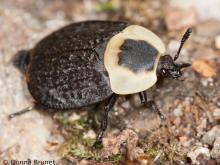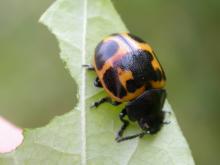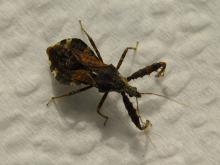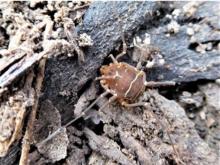Land Invertebrates
Media

Species Types
Scientific Name
Necrophila americana
Description
The American carrion beetle has a yellow pronotum with a big black spot in the middle. Adults of this species of silphid beetle eat fly maggots, plus some carrion. In flight, they seem like bumblebees.
Media

Species Types
Scientific Name
About 28 species in North America
Description
Horntails look a lot like wasps but have a taillike spine that projects from the tip of the abdomen. Their cylindrical bodies also lack the narrow waist so common in wasps.
Media

Species Types
Scientific Name
Tetraopes spp.
Description
Milkweed longhorns are a genus of longhorned beetles that feed on milkweed. They are red with black spots. The species are very similar.
Media

Species Types
Scientific Name
Labidomera clivicollis
Description
The swamp milkweed leaf beetle is found on the various milkweeds it eats, often in grassy areas or on roadsides. The exact pattern of orange and black varies among individuals.
Media

Species Types
Scientific Name
About 20 species in North America north of Mexico
Description
Scoliid wasps are a family of beetle hunters. Large, rather hairy wasps, some are handsomely colored. The female digs in soil, finds a scarab beetle grub, and lays an egg on it.
Media

Species Types
Scientific Name
Araneus marmoreus
Description
The marbled orbweaver is sometimes called the “pumpkin spider” because its rounded abdomen is sometimes bright orange. The color and markings can vary greatly.
Media

Species Types
Scientific Name
Sinea spinipes
Description
The spiny assassin bug is one of nearly 200 species of assassin bugs in North America. It walks, hops, and flies to capture its insect prey.
Media

Species Types
Scientific Name
Anthrax georgicus
Description
The field coal bee fly, Anthrax georgicus, has no real common name. Look for it in grasslands, fields, and other open areas.
Media

Species Types
Scientific Name
Meloe spp.
Description
Blister beetles in the genus Meloe are called oil beetles because of a yellowish oil they excrete from their joints when squeezed or distressed. This oil contains cantharidin, an irritating chemical that can cause blistering in many people.
Media

Species Types
Scientific Name
Members of suborder Laniatores
Description
Armored harvestmen have spines on their fingerlike mouthparts (pedipalps). Unlike other harvestmen, members of this suborder of so-called daddy longlegs do not usually have long legs.
See Also



Media

Species Types
Scientific Name
Cisseps fulvicollis
Description
The yellow-collared scape moth is more often “orange-collared.” And whether you think it looks more like a firefly or a wasp, it’s still a moth!
Media

Species Types
Scientific Name
Nearly 150 species in North America north of Mexico
Description
Slim, delicate plume moths are instantly recognizable by their T-shaped silhouette, long legs, and muted shades of tan and brown. It can be hard to separate the various species.
Media

Species Types
Scientific Name
Pyrrharctia isabella
Description
Not many people know the adult Isabella tiger moth when they see one, but we’re all acquainted with its caterpillar, the woolly worm, or woolly bear.
About Land Invertebrates in Missouri
Invertebrates are animals without backbones, including earthworms, slugs, snails, and arthropods. Arthropods—invertebrates with “jointed legs” — are a group of invertebrates that includes crayfish, shrimp, millipedes, centipedes, mites, spiders, and insects. There may be as many as 10 million species of insects alive on earth today, and they probably constitute more than 90 percent all animal species.





















